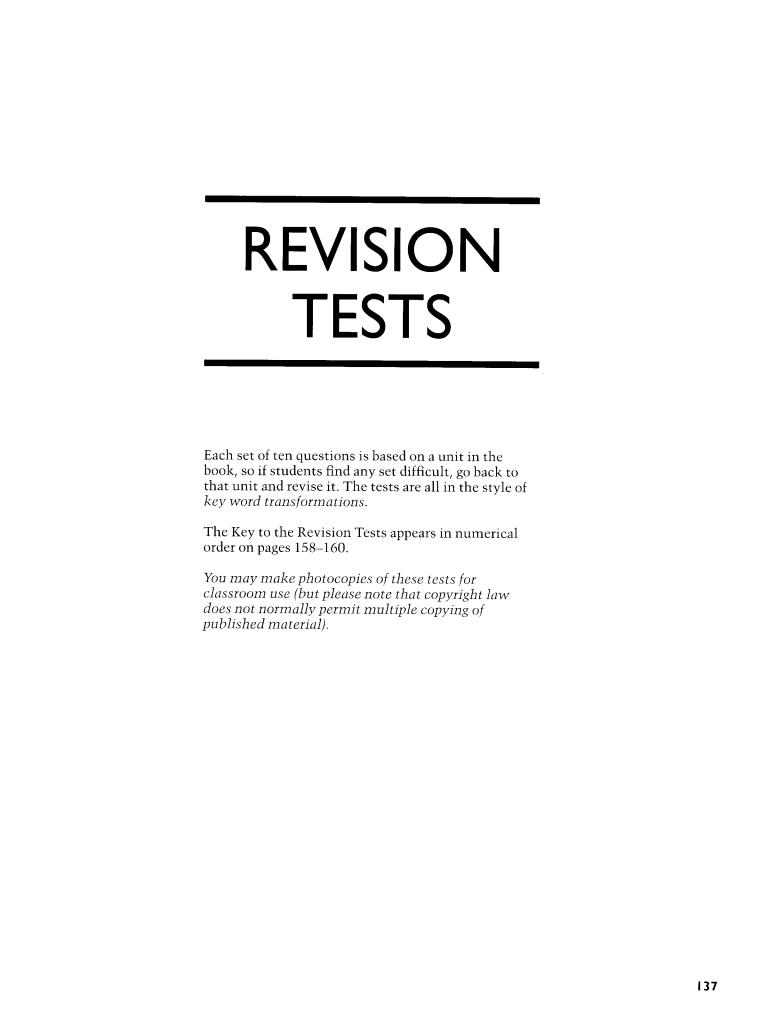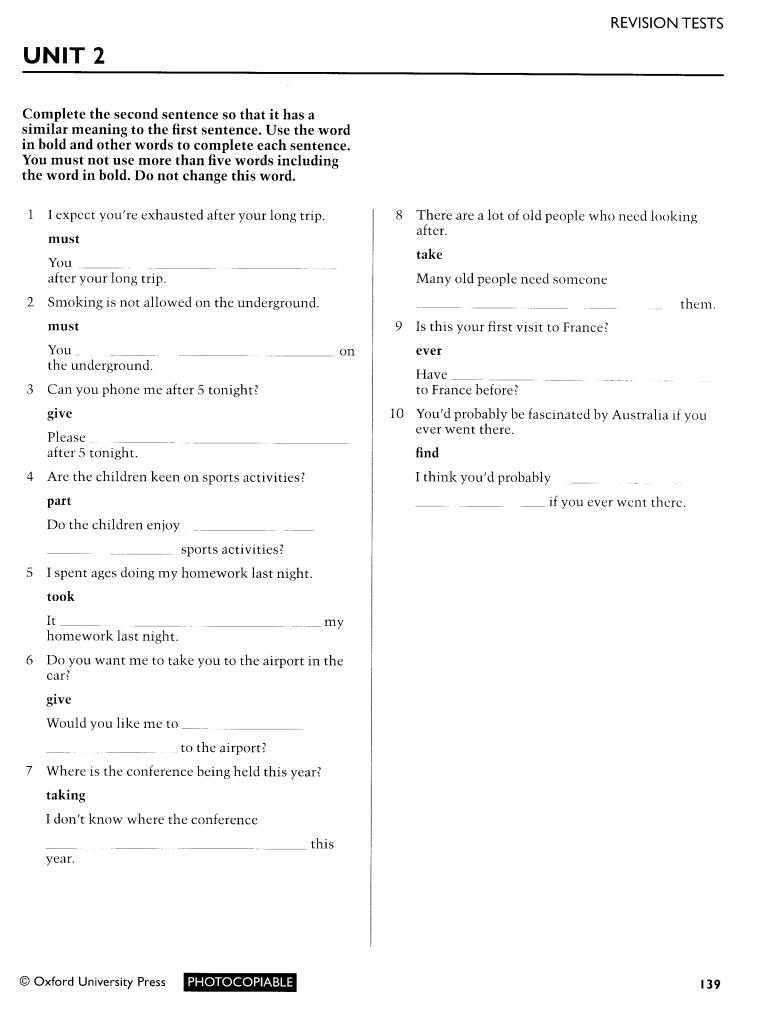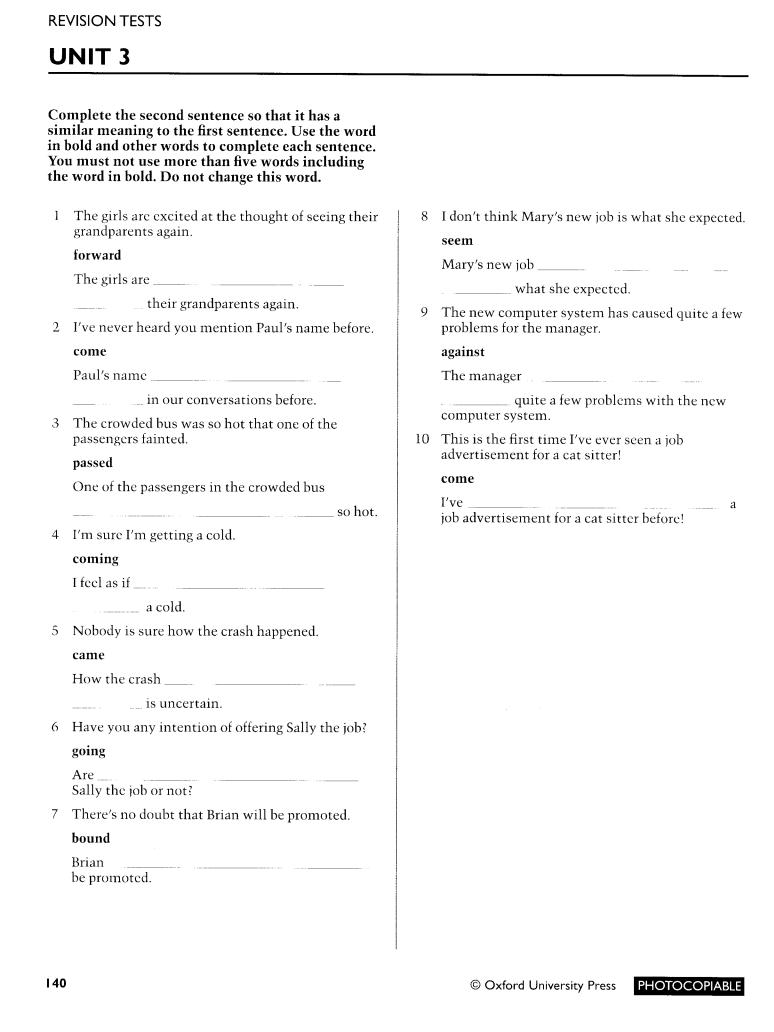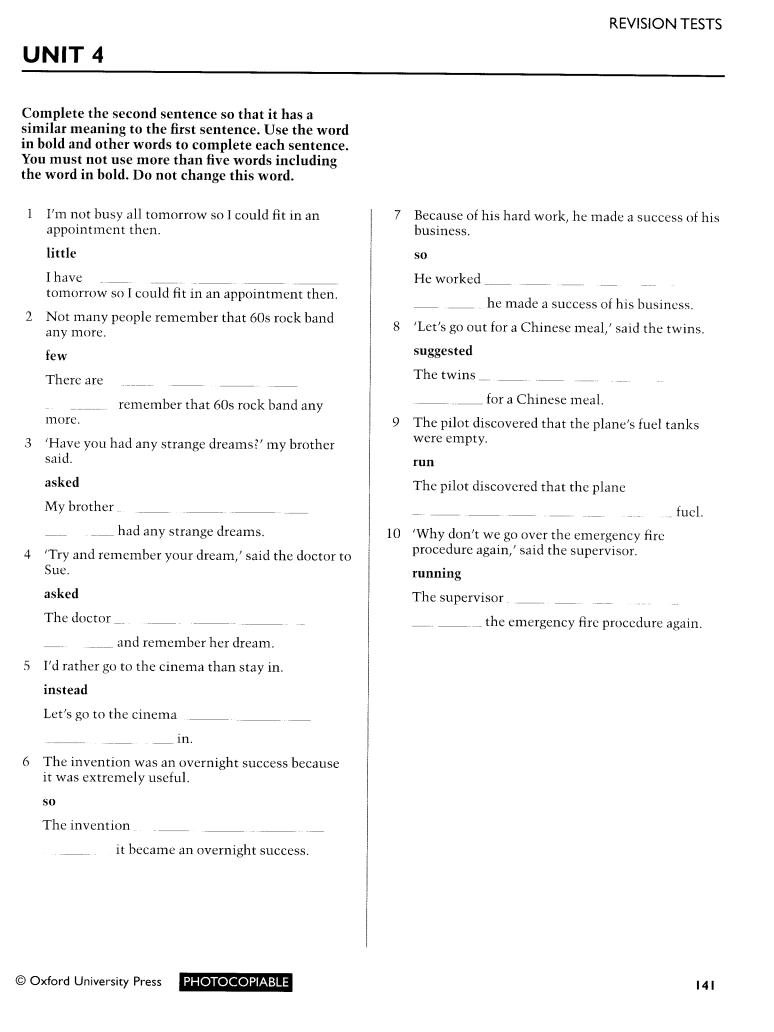
решебник учебника
.pdf
20
THE LOST CIVILIZATION
FOCUS ONE |
SB 154–155 |
■SPEAKING
■READING
■VOCABULARY
■LANGUAGE STUDY
Review of phrasal verbs
SPEAKING
Ask students to study the picture without looking at the questions in their books and suggest what it could be / mean and where it could / might come from.
In pairs, ask students to discuss questions 1 and 2 in their books, then compare their opinions with another pair.
READING
EXERCISE A
Ask students to try this ‘missing paragraph’ reading task on their own as if they were doing it in an exam. Allow 10 minutes for them to do this, then ask them to compare their answers with another student.
Answers
1 B 2 F 3 D 4 A
EXERCISE B
Divide the class into small groups and ask them to discuss what helped them to choose their answers if they were correct.
VOCABULARY
Answers |
|
|
|
|
|
1 |
desert |
4 |
plain |
7 |
develop |
2 |
inhabited |
5 |
general |
8 |
disprove |
3 |
destroy |
6 |
ordinary |
|
|
|
|
|
|
|
|
LANGUAGE STUDY
Review of phrasal verbs
Again, allow students to do this exercise on their own before comparing their answers with a partner. When they have finished, ask students if they can explain what the phrasal verbs mean, e.g. 1 the answer is broke (down), which means collapsed or stopped functioning.
Answers |
|
|
|
|
|
1 |
broke |
5 |
on |
9 |
come |
2 |
about |
6 |
cut |
10 |
come |
3 |
out |
7 |
came / went |
11 |
face |
4 |
through |
8 |
looking |
12 |
give |
|
|
|
|
|
|
FOCUS TWO |
SB 156–157 |
■LISTENING
Part 1 Part 2
■VOCABULARY
■LANGUAGE STUDY
General revision 1
LISTENING
Part 1
EXERCISE A
Give students this task as a timed test. Allow students time to read through the notes in 1–5 before playing the tape. Do not stop the tape or allow them to talk to their neighbours in between the parts. Play the tape once.
Tapescript
G = Guide
G: Ladies and gentlemen, Chichen Itza is one of the most famous Mayan cities. But I should warn you that the stories behind the beautiful buildings we are about to visit can be frightening …even
…uh … rather horrifying.
…And here we are now in front of the Temple of Kukulcan … the God of the Mayas. The building at the top with the flat roof is the
UNIT 20 • 131
NEW SUCCESS AT FIRST CERTIFICATE TEACHER’S BOOK
© Oxford University Press www.oup.com/elt

temple itself and, as you can see, it’s quite a climb to the top. In fact, if you count the steps as we climb them, you will find that there are exactly 364 steps … and if you count the roof, it comes to 365, the same number as the days in the year. The Mayas were very interested in astronomy, you see. Their religion was based on it, and every year they would sacrifice children to the gods in this very temple …where you can see the carving of their god, Kukulcan, the snake with feathers.
…And now here we are at the top of the pyramid, and the building you can see behind us and to your right is the Observatory; can you see it over there, sir? With the round building on the top? Scientists believe that the Mayas made a number of important discoveries and observations of the stars in the Observatory. They knew a great deal about the planets. For instance, they knew that the earth was round as well as how long the years were on Mars and Venus.
…This wonderful building is known as ‘The Temple of the Warriors’; it was probably built around 1100 AD, later than the other buildings. It is also known as ‘The Thousand Columns’, because of all the columns you can see around you. This is where the soldiers of the Mayas would pray before going into battle. It is believed, by the way, that the Mayas went to war mainly in order to capture prisoners from other tribes. These prisoners were sacrificed to the gods. Perhaps they spent their last days here, among the thousand columns, before the … uh … day of the sacrifice came.
…And now we’re standing by the ‘Well of Sacrifice’ … where more sacrifices used to take place. The Mayas used to throw the bodies of their victims into the black water of the well in order to make Chac, their rain god, happy. The well was thought to be bottomless.
Perhaps you can imagine, ladies and gentlemen, the terrible screams of the victims just before they were sacrificed … right here, where we are standing now.
…And this is known as the ‘Ball Court’ … it was the scene of a very strange game. The purpose of the game was to throw a hard rubber ball through one of the rings you can see in the middle of the court. It seems that the captain and sometimes the players of the losing team were beheaded after the end of a game. Perhaps we would win the next World Cup if we started doing the same thing to the captain and players of our national football teams?!
Answers
1 C 2 D 3 B 4 A 5 E
EXERCISE B
Allow students time to read through the information in 6–11. Now play the tape again and check the answers. (7 is the ‘extra’ description that is not needed.)
Answers
6 B 7 — 8 E 9 D 10 C 11 A
Part 2
Ask students to read through the notes carefully before they listen to the tape. Play the tape twice before checking students’ answers.
Tapescript
Part 2
Now, ladies and gentlemen, this particular ball court was probably built in about 1194, that is to say towards the very end of the PostClassical period. At 450 feet, or 137 metres, it’s by far the longest
court to be found at any Mayan site. These two parallel walls are exactly 30 metres apart, and 8.2 metres high.
Now, it’s clear that the game was very important in Mayan society, because all the other major Mayan cities have similar buildings, although many of them are smaller and date from an earlier period. We believe that the spectators would have stood along the top of the walls and looked down, so the game was a sport that was played nationally. The game could also have been important in terms of Mayan religion – there is evidence for this theory in sculptures which show people playing the game in the presence of priests and kings.
We get a fairly good idea of the rules of the game from Mayan carvings. It appears that there were usually two sides, and between six and nine members on each team. The aim was to get the ball through one of the iron rings at the top of the wall – a little like a basketball net – except that the players couldn’t use their hands, and had to kick the ball with their feet, or knees or elbows.
The penalty for losing was sometimes death; the head of one or more members of the losing team would be presented to the winners as a prize. We know that the game was played very seriously during the major religious festivals. But there are also carvings that show winners being given coffee – coffee beans were used just like money – and sometimes, the losers simply lost their clothes to the winners, as in fact did their supporters who were watching from the top of the walls.
Answers
121194
138.2 metres
14all major Mayan cities
15a national sport
16religious importance / significance
17sculptures
18carvings
19six and nine people
20an iron ring
21use their hands
22were killed / beheaded / executed
23during the major religious festivals
24coffee
25money
26the losing team
27(of) their supporters
VOCABULARY
Play a team game. Divide the class into four or six teams. The first team to finish the exercise correctly wins!
Answers
1 C |
2 A 3 D 4 D 5 D 6 A 7 C 8 B |
9 A |
10 D 11 D 12 B 13 B 14 A 15 C |
Ask students if they think there is any truth in the strange story they have just read.
132 • UNIT 20
NEW SUCCESS AT FIRST CERTIFICATE TEACHER’S BOOK
© Oxford University Press www.oup.com/elt

LANGUAGE STUDY
General revision 1
Keeping the same teams as for the previous exercise, see which team can finish the exercise correctly first.
Answers
1looking forward to seeing
2he had never seen anything
3wondered where the people had
4spite of his illness
5other cities were more difficult
6succeeded in returning
7took Stephens three months to
8found it very interesting
9was such a good book
10has been ages since
Go over any points that students have forgotten or are uncertain about.
FOCUS THREE |
SB 158–159 |
■READING
■SPEAKING
Talking about yourself Problem solving Discussion
■WRITING
■LANGUAGE STUDY
General revision 2
READING
Ask students to do these tasks on their own before comparing their answers with a partner.
EXERCISE A
1 ROUGH GUIDE TO VALLARTA
Answers |
|
he (line 3) |
Mexican (line 6) |
the (line 4) |
about (line 7) |
a (line 5) |
as (line 8) |
|
|
2 |
SURF AND TURF |
|
|
|
|
|
|
|
|
|
|
Answers |
|
|
|
|
|
will (line 1) |
|
yourself (line 7) |
|
|
|
the (line 2) |
|
After (line 9) |
|
|
|
be (line 3) |
|
most (line 10) |
|
|
|
there (line 6) |
|
an (line 11) |
|
|
|
have (line 6) |
|
|
|
|
|
|
|
|
|
|
|
EXERCISE B |
|
|
|
|
|
3 MEXICO CITY / 4 |
FIESTA MEXICANA |
||||
|
|
|
|
|
|
Answers |
|
|
|
|
|
1 |
fascinating |
5 |
inclusive |
8 |
impressive |
2 |
wonderful |
6 |
comfortable |
9 |
enjoyable |
3 |
civilizations |
7 |
flights |
10 |
choice |
4 |
sights |
|
|
|
|
|
|
|
|
|
|
EXERCISE C
5BACK TO NATURE BBQ CRUISE /
6SAILING CHARTERS
Answers |
|
|
|
|
|
1 |
all |
6 |
where |
11 |
for |
2 |
behind |
7 |
are |
12 |
as |
3 |
on / aboard |
8 |
or |
13 |
of |
4 |
the |
9 |
from |
14 |
to |
5 |
which |
10 |
of |
15 |
out |
|
|
|
|
|
|
SPEAKING
EXERCISE A
Talking about yourself
In pairs or groups of three, tell students to ask and answer questions 1–3 in their books.
EXERCISE B
Problem solving
In the same pairs or groups, ask students to plan a one–day excursion. Allow about 3–4 minutes for this, then ask them to compare their ideas with another pair or group.
EXERCISE C
Discussion
In the same pairs or groups ask students to discuss questions 1 and 2 in their books. Allow about 3–4 minutes for this.
UNIT 20 • 133
NEW SUCCESS AT FIRST CERTIFICATE TEACHER’S BOOK
© Oxford University Press www.oup.com/elt

WRITING
Allow about 5 minutes for this activity, then ask two students to compare what they have written.
LANGUAGE STUDY
General revision 2
In different groups, allow students about five minutes to complete this exercise, then check answers with the class as a whole.
Answers
1gave a talk on
2took me an hour to
3give me a lift
4take care of
5make all the arrangements
6did a course in
7had a good time on
8had a long conversation with
9make a decision about
10have a look at
11think Uxmal was as impressive
12wish we could
13was too tired to go
14had this dress made for
15best hotel I have ever
16you find ancient cities interesting
17you mind coming back
18asked the tourists not to
19to stop taking any more
20are tired of revising
FOCUS FOUR |
SB 160 |
■WRITING
Report 3
WRITING
Report 3
Ask students to read the information at the top of the page.
EXERCISE A
Ask students to read the sample task and discuss what they would put in the answer.
EXERCISE B
Ask students to read the sample answer and, in pairs, choose the best heading for each paragraph.
Answers
1 E 2 B 3 C 4 D 5 A
EXERCISE C
Ask students, in pairs, to read the writing task and discuss what might appear in their report. Point out that they can write either about their home town or about the place where they are studying.
EXERCISE D
Ask students to read through the questions carefully, then write the report covering points 1–6 in E, either in class, or for homework.
FOCUS FIVE |
SB 161 |
■REVISION AND EXTENSION
■LANGUAGE STUDY
General revision 3
REVISION AND EXTENSION
Answers
1 A 2 B 3 D 4 B 5 C 6 B 7 D 8 D 9 D 10 C 11 A 12 D 13 B 14 B 15 A
LANGUAGE STUDY
General revision 3
Answers
1in case the banks are
2must have seen the thief
3had concentrated, I would not / wouldn’t
4since I was able
5did not pay much for
6only does Mary dance
7has been walking for
8asked the teacher to explain
9would not have left
10should have been done
11as if you know
12remember studying / that we studied
13 wondered if / whether he was telling |
|
134 • UNIT 20
NEW SUCCESS AT FIRST CERTIFICATE TEACHER’S BOOK
© Oxford University Press www.oup.com/elt

14warned me not to cause
15urged us to study
16remember to answer
17wish I had more time
18enjoyed using
WORKBOOK KEY WB 90–96
EXERCISE A
1 G 2 A 3 B 4 H 5 E 6 C The extra sentence is D.
EXERCISE B |
|
|
|
|
|
1 |
dissolve |
4 |
ancient |
7 |
reduced |
2 |
carvings / statues |
5 |
ruins |
8 |
debts |
3 |
eroded |
6 |
spectacular |
|
|
EXERCISE C
1was such a success
2ages since I last saw
3been speeding, he wouldn’t
4took them three days to
5is much / far too young
6thief must have had
7find it difficult to learn
8blamed Jane for losing
9you mind lending me
10took good care of
EXERCISE D |
|
|
|
|
|
1 |
it |
6 |
well |
11 |
Even |
2 |
Although / While |
7 |
same |
12 |
of |
3 |
over |
8 |
not |
13 |
take |
4 |
on |
9 |
but |
14 |
used |
5 |
who |
10 |
as |
15 |
it |
EXERCISE E
1 C 2 A 3 D 4 A 5 D 6 D 7 B 8 D 9 D 10 B 11 D 12 D 13 D 14 B 15 D
EXERCISE F
1 A 2 D 3 C 4 A 5 A 6 D 7 C 8 B 9 D 10 B 11 C 12 C 13 B 14 B
EXERCISE G |
|
|
|
|
|
1 |
scientific |
|
6 |
excitement |
|
2 |
interested |
|
7 |
endless |
|
3 |
dramatic |
|
8 |
discoveries |
|
4 |
repetitive |
|
9 |
unimportant |
|
5 |
dangerous |
|
10 |
understanding |
|
EXERCISE H |
|
|
|
|
|
1 |
brought |
4 |
made |
7 |
pick |
2 |
broke |
5 |
fell |
8 |
looking |
3 |
drop |
6 |
run |
|
|
Message: Good luck
|
PROGRESS TEST 4 |
WB 95–96 |
|||
EXERCISE A |
|
|
|
|
|
1 C 2 D 3 D 4 C 5 C 6 D 7 A 8 B |
|
||||
9 B |
10 B 11 C 12 A |
13 B 14 D |
15 C |
|
|
EXERCISE B |
|
|
|
|
|
1 |
seemed / appeared |
6 |
had |
11 |
As |
2 |
out |
7 |
used |
12 |
by |
3 |
even |
8 |
what |
13 |
little |
4 |
on |
9 |
made |
14 |
have |
5 |
of |
10 |
managed |
15 |
had |
EXERCISE C
1could be seen
2in case he decides to
3must have had
4had better not be / arrive
5get on / along (well) with each
6it’s time you got
7will have finished by
8made it possible for Sally
9have phoned if I had
10whether or not
EXERCISE D |
|
|
|
1 |
successful |
6 |
impressed |
2 |
organization |
7 |
inaccurate |
3 |
scientists |
8 |
embarrassing |
4 |
invention |
9 |
Shortly |
5 |
achievements |
10 |
impossible |
UNIT 20 • 135
NEW SUCCESS AT FIRST CERTIFICATE TEACHER’S BOOK
© Oxford University Press www.oup.com/elt





